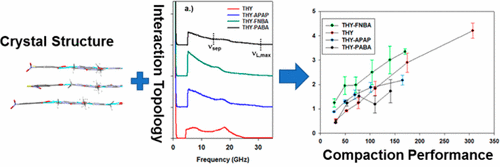当前位置:
X-MOL 学术
›
Cryst. Growth Des.
›
论文详情
Our official English website, www.x-mol.net, welcomes your feedback! (Note: you will need to create a separate account there.)
Combining Crystal Structure and Interaction Topology for Interpreting Functional Molecular Solids: A Study of Theophylline Cocrystals
Crystal Growth & Design ( IF 3.8 ) Pub Date : 2017-11-03 00:00:00 , DOI: 10.1021/acs.cgd.7b01339 Aditya B. Singaraju 1 , Kyle Nguyen 1 , Paula Gawedzki 1 , Fischer Herald 1 , Gavin Meyer 1 , Daniel Wentworth 1 , Dale C. Swenson 1 , Lewis L. Stevens 1
Crystal Growth & Design ( IF 3.8 ) Pub Date : 2017-11-03 00:00:00 , DOI: 10.1021/acs.cgd.7b01339 Aditya B. Singaraju 1 , Kyle Nguyen 1 , Paula Gawedzki 1 , Fischer Herald 1 , Gavin Meyer 1 , Daniel Wentworth 1 , Dale C. Swenson 1 , Lewis L. Stevens 1
Affiliation

|
The acoustic frequency distributions, mechanical moduli, and crystal structures for theophylline (THY) and three cocrystals are combined to illustrate how supramolecular organization and interaction topology contribute to the compaction performance of molecular solids. A novel solid form of THY, a cocrystal with 4-fluoro-3-nitrobenzoic acid (FNBA), is reported. This material adopts a 2d-layered structure and has superior tabletability relative to THY. The improved plasticity for THY–FNBA was further corroborated by Heckel analysis with THY–FNBA displaying a reduced yield pressure (Py) relative to theophylline. The performance of THY–FNBA was further compared to a structurally similar theophylline cocrystal with acetaminophen (THY–APAP). Despite structural similarity, their relative compaction performance was distinct. Powder Brillouin light scattering (p-BLS) was used as an experimental measure of the interaction topologies of these materials, and through this approach, the interlayer interaction strength is shown to be weaker relative to THY–APAP. Moreover, a THY and p-aminobenzoic acid (PABA) cocrystal was studied to contrast the performance of two columnar crystal structures, THY–PABA and THY. THY–PABA displayed a stacking structure that frustrated sli,p and the compaction performance was consequently diminished. The elasticity moduli were further determined for all materials, and both THY–APAP and THY–FNBA displayed low Young’s and shear moduli and is consistent with our compaction studies.
中文翻译:

结合晶体结构和相互作用拓扑解释功能分子固体:茶碱共晶体的研究
茶碱(THY)和三个共晶体的声频分布,机械模量和晶体结构被结合起来,以说明超分子的组织和相互作用的拓扑如何影响分子固体的压实性能。据报道,新型的THY固体形式是与4-氟-3-硝基苯甲酸(FNBA)的共结晶。该材料采用二维层结构,相对于THY具有优异的压片性。Heckel分析进一步证实了THY–FNBA可塑性的提高,因为THY–FNBA的屈服压力降低了(P y)相对于茶碱。THY–FNBA的性能进一步与结构相似的茶碱与对乙酰氨基酚(THY–APAP)进行了比较。尽管结构相似,但它们的相对压实性能却截然不同。粉末布里渊光散射(p-BLS)被用作这些材料相互作用拓扑的实验测量,并且通过这种方法,层间相互作用强度相对于THY-APAP较弱。此外,THY和p-氨基苯甲酸(PABA)共晶体进行了研究,以对比两种柱状晶体结构THY–PABA和THY的性能。THY-PABA表现出使sli,p受挫的堆叠结构,因此压实性能降低。进一步确定了所有材料的弹性模量,THY-APAP和THY-FNBA均显示出较低的杨氏模量和剪切模量,与我们的压实研究一致。
更新日期:2017-11-05
中文翻译:

结合晶体结构和相互作用拓扑解释功能分子固体:茶碱共晶体的研究
茶碱(THY)和三个共晶体的声频分布,机械模量和晶体结构被结合起来,以说明超分子的组织和相互作用的拓扑如何影响分子固体的压实性能。据报道,新型的THY固体形式是与4-氟-3-硝基苯甲酸(FNBA)的共结晶。该材料采用二维层结构,相对于THY具有优异的压片性。Heckel分析进一步证实了THY–FNBA可塑性的提高,因为THY–FNBA的屈服压力降低了(P y)相对于茶碱。THY–FNBA的性能进一步与结构相似的茶碱与对乙酰氨基酚(THY–APAP)进行了比较。尽管结构相似,但它们的相对压实性能却截然不同。粉末布里渊光散射(p-BLS)被用作这些材料相互作用拓扑的实验测量,并且通过这种方法,层间相互作用强度相对于THY-APAP较弱。此外,THY和p-氨基苯甲酸(PABA)共晶体进行了研究,以对比两种柱状晶体结构THY–PABA和THY的性能。THY-PABA表现出使sli,p受挫的堆叠结构,因此压实性能降低。进一步确定了所有材料的弹性模量,THY-APAP和THY-FNBA均显示出较低的杨氏模量和剪切模量,与我们的压实研究一致。



























 京公网安备 11010802027423号
京公网安备 11010802027423号